-

人教版新课标小学数学二年级上册角的初步认识教案2篇
【课中安排学唱《可爱的角》这首歌曲,旋律是学生熟悉并喜爱的,加上简明扼要的歌词和动作,提高了孩子们的兴趣。】四、课堂活动(课件出示)1.辨角。用你火眼金睛找出哪些是角?哪些不是角?为什么?(练习八的第1题)【在学生对角建立起概念的前提下,让学生做该练习,从而加深了学生对角的认识,增强分析、判断能力。这个练习可以叫它“跟随”练习,即刚学会一个新的概念,认识一个新的内容之后,紧跟着的一个比较容易的以选择和判断为主的练习。】2.数角(练习八的第2题)。师:小马看见小朋友们都认识了角,非常高兴,看看天色不早了,赶紧赶路,跑了一会儿,看见图形王国里面有许多图形,但小马不知道各有几个角?小朋友们能帮助它数一数吗?【这是一道“巩固”练习,让学生将所学知识做一次运用,难度稍加大,但学生能做出来,并且能找到练习中的规律,能享受到一种成就感。】
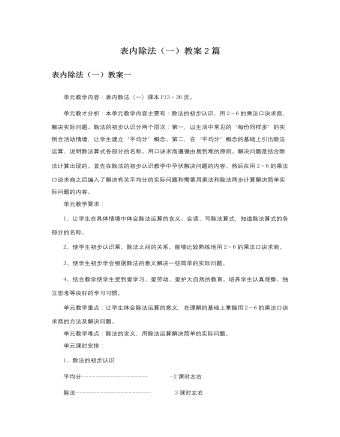
人教版新课标小学数学二年级下册表内除法(一)教案2篇
教后反思本节课给学生创设了良好的活动空间,把学生实际生活中听说过的见到的平均分现象展示给学生看,把生活和数学联系起来,在学生感受“同样多”的基础上概括出什么叫平均分。揭示平均分这一数学知识在生活中的应用,之后突出了学生三次实际操作。第一次,小组同学互相分水果,重视学生分的结果。体会感受“平均分”的含义。第二次,重视分法:15个橘子平均分成5份。体现了学生对物品的不同分法,建立了平均分的概念。第三次,分矿泉水,通过份数变化,观察分的就结果,深刻体会“平均分”,为认识除法积累丰富的知识。为学生营造探索的空间。第二课时:平均分的认识(二)教学内容巩固“平均分”。课本第15页的例题3。教学目标1.巩固“平均分”的概念,知道平均分就是每一份分得结果同样多。
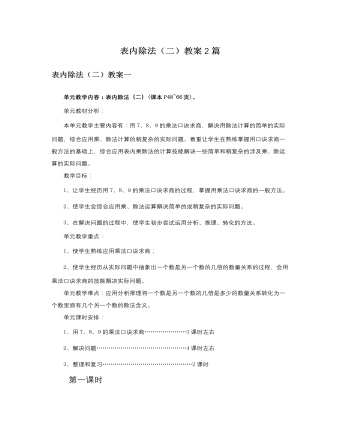
人教版新课标小学数学二年级下册表内除法(二)教案2篇
三维目标1.知识与技能(1)让学生经历用7、8、9的乘法口诀求商的过程,掌握用乘法口诀求商的一般方法。(2)使学生会综合应用乘、除法运算解决简单的或稍复杂的实际问题。2.过程与方法在解决问题的过程中,让学生初步尝试运用分析、推理和转化的学习方法。3.情感、态度与价值观让学生在学习中体验到成功的喜悦,增强学生学好数学的信心。重、难点与关键1.重点:使学生熟练应用乘法口诀求商,经历从实际问题中抽象出一个数是另一个数的几倍的数量关系的过程,会用乘法口诀求商的技能解决实际问题。2.难点:应用分析推理将一个数是另一个数的几倍是多少的数量关系转化为一个数里面有几个另一个数的除法含义。3.关键:以解决问题为载体,培养学生的数感。

人教版高中英语必修3Canada-the true north说课稿4篇
Good afternoon, teachers, It’s my great pleasure to be here sharing my lesson with you.The content of my lesson is Senior English Book 3 Unit 5 Canada —— “The true North”.I’ll be ready to begin this lesson from five parts. Analysis of the teaching material,the teaching methods,the studying methods, the teaching procedure,and Blackboard design.First, let me talk about the teaching material.Part 1 Teaching Material:This unit is about the introduction of Canada. By studying of this unit,we’ll enable the students to learn the geography, population, main cities, and natural beauty, natural resources of Canada. Through the training of the unit, it also requires students to learn some Language skills such as the expressions of position and emotions.So it plays an important part in the English teaching in this book.After studying the teaching material and analyzing the rule of children’s growing of mind,I think the teaching aims are the followings:1.Knowledge objects:(1) make the students learn some new words and phrases(2) make the students understand the content of the lesson.2.Ability objects:(1)To develop the Ss’ abilities of listening, speaking, reading and writing. Especially reading and speaking ability.(2) learn to talk about the characters of Canada in English(3)To train the Ss’ ability of working in pairs.3.Emotion objects:(1)Enable students to understand the characters of Canada..(2)Stimulate Ss to work hard to make China stronger.Part 2 Teaching Methods:I think helping students learn to master new words and phrases and improve the students’ reading and speaking ability is import and the difficult.According to the analysis of the teaching material and the import points and the difficult points,I will use the following teaching methods : question-guiding approach; fast-reading and careful reading; multi-media teaching methods; discussion

人教版高中英语必修3Festivals around the World说课稿3篇
Teaching plan for Unit 1 book3Good morning, teachers. It’s my great pleasure to be here because I can share my lesson with you and I can learn a lot from it. I’ll begin my lesson from the following four parts, the teaching material, the teaching methods, the studying methods and the teaching procedure.Firstly, let me talk about the teaching material. The content of my lesson is the reading passage festivals and celebrations of Unit 1 Festivals around the world. This passage is about festivals and celebrations. By studying this passage, we’ll enable the students to know that festivals exit everywhere, and many of festivals in different countries celebrate similar ideas. As we all know, the reading passage is the center of each unit. If the Ss can learn it well, it will be helpful to make the Ss learn the rest of this unit.After studying the teaching material, I think the teaching aims are as the followings:1. Knowledge aims:(1) The Ss can master the usage of the important words andexpressions.(2)The Ss can use the __________________ (grammar) in the proper situation.Make students know about the festivals all over the world and the detail of the festivals, such as origin, content, and the date of the holiday festivals.2. Ability aims:(1) Students can talk about festivals and celebrations in English(2) To improve the student’s reading ability, especially their skimming and scanning ability.3. Emotion aims:Make the Ss know about the foreign festivals, and respect other countries’ custom.Next, let’s come to the important points and the difficult points.The important point is how to make the Ss understand the text better and the difficult point is how can they talk about it. secondly, Teaching Methods:1. task-based Language Teaching2. Computer assisted language teaching.3. question-and–answer methodThirdly, Studying Methods:

人教版高中英语必修4Working The Land说课稿3篇
Knowledge objectives:(1) to make Ss grasp the usage of words, expressions and sentence structures: statistics, struggle, thanks to, rid of, some patterns for persuasion, the “ing” form as subject and object;(2)to use learnt knowledge to persuade sb.Ability objectives:(1) to develop Ss’ reading skills(skimming, scanning, word guessing);(2) to improve Ss’ speaking, communicating and cooperating skills.Emotional objectives:to make Ss know the contribution of Yuan,and learn his spirit and his simple life time.Teaching important and difficult points:(1) some words, expressions and sentence structures mentioned above;(2)the content of the text;(3)training their reading and speaking skills.Teaching methods: CLT, TBLT,QT.Learning strategies: CLS, QLS, TBLS.Teaching procedures:Step 1 lead-in: (1) teacher plays a piece of recent news from CCTV about the harvest of the super hybrid rice, and ask students whether they know Yuan or not, and talk about him and his contribution.(2)Brain storm: let Ss describe Yuan in their minds including his appearance, his living condition and so on.Step 2 fast reading tasks:(1)teacher introduces Yuan and super hybrid rice(2)make Ss read the text as fast as possible with questions. Such as: what’s the general ideaof this passage? What’s Yuan’ dream? (skimming and scanning skill)Step 3 intensive reading tasks(1)let Ss read the text silently, find topic sentence of each paragraph and draw the difficult sentences and the knowledge what they don’t understand.(words guessing)(2)teacher and Ss talk about the important words, expressions and sentences together, and ask Ss to retell the content of the text.(summarizing and paraphrasing)(3)teacher summarize this part.(4) read again following the courseware.

人教版高中英语必修3The million pound bank note说课稿3篇
在接下来的细读环节,我套用了高考对阅读理解的考查方式设置了5个问题,分别为三个推理判断题,一个细节题和一个主旨大意题。学生需要对文章的内容进行分析、归纳、推理、猜测等高级思维活动才能做出正确的回答。【设计意图】这一过程是对学生进行细读的训练,培养学生获取特定信息和挖掘文章深层次信息的能力。第三环节:Intensive-reading (精读) 15′第三个环节精读,既是最重要的环节,也是突破本课重难点的关键。首先,让学生思考剧本中人物看到百万英镑前后的态度发生了怎样的变化。其次,让学生仔细阅读文章,找出可以表现人物态度变化的具体的语言和动作。最后,让学生总结人物的态度发生变化的根本原因是什么,从而引出Money Talks, 供学生思考。【设计意图】通过一系列的活动培养学生学习从人物的语言和动作探究人物的心理,使学生进一步体会戏剧语言的魅力,从而对文章背后所反映的社会问题进行思考,也为下一步的讨论环节做好铺垫。

人教版高中英语必修5Life in the Future说课稿5篇
Good afternoon, everyone. It’s my great pleasure to be here sharing my lesson with you. The content of my lesson is Senior English for China Book5 Unit 3 Life in the Future. I’ll be ready to begin this lesson from six parts: Analysis of the teaching material, Analysis of the students, Teaching aims and important and difficult points, Teaching methods and aids, Teaching procedures, and Blackboard design. First, let me talk about the teaching material.Part 1 Analysis of the Teaching Material:This unit is about what human beings’ life will be like in about one thousand years. By studying of this unit, we’ll Enable the students to know the changes in humans’ life and some new inventions bringing about the change and develop the interest in science. This lesson plays an important part in the English teaching in this unit. This is an important lesson in Book Five. From this lesson, it starts asking the Ss to grasp contents of each passage. Therefore, this lesson is in the important position of the teaching material. If the Ss can learn it well, it will be helpful to make the Ss learn the rest of this unit.Part 2 Analysis of the SsAs Senior2 Ss, they are at different levels of English fluency, some of them have lost interest in English. So during the lesson, I arrange a variety of activities to let all of them join in to attract their interest and let them be confident and taste the joy of success.

人教版高中英语必修5Making the news说课稿4篇
今天我们来介绍一下必修五第四单元的授课方式。这个单元的题目是Making the news。应该是学生比较感兴趣的话题,学生往往对新闻工作充满好奇,所以我们可以利用这个机会多设计一些师生互动和学生互动,来激发起学习的积极性,提高学习效率。同时我们可以利用这个单元不仅帮助学生掌握语言知识,培养语言能力,同时让其了解新闻工作的重要性,培养起社会智能感。这个单元分为六个课时,它的教学目标是这样的:语言目标是掌握词汇表中的常用单词和短语,掌握倒装句的一些基本用法。 技能目标是能初步掌握约会的基本句型并在真实的场景下正确运用。新闻报道类文章的写作技能。采访的基本规范和沟通技能。情感目标是对新闻报道的客观性和真实性有更好的理解。对新闻记者的职业有更深入的了解,并能体会其工作的重要性。下面我们来介绍一下第一课时的授课方式,第一课的教学目标是这样的第一课时的教学目标语言目标:单词:Occupation, journalist, editor, photographer, curious, personality, enthusiasm

人教版高中英语必修5The United Kingdom说课稿4篇
Teaching Aims:Knowledge 1. Get the students to learn the useful new words and expressions in this section. Aims:2. Let the students learn about how the UK was formed and the four groups of invaders.1. Develop students’ reading ability and let them learn different Ability reading skills. Aims:2. Enable students to learn to talk about the United Kingdom and the Union Jack Emotional 1. Let students know more about the UK2. Develop students’ sense of cooperative learning Aims:Teaching Important Points:1. Let the students learn about the countries of the United Kingdom and the Union Jack2. Get the students to read the passage and know about how the UK was formed and the four groups of invaders.3. Have the students learn different reading skills.Teaching Difficult Ponts:1. Develop students’ reading ability.2. Enable students to talk about the United Kingdom and the Union Jack.3. Let students learn how the UK was formed geographically and historically.Teaching Methods:Showing pictures, asking, exercising, listening, reading etc.Teaching Aids:A computer,a projector and a blackboard.Teaching Procedures: 1) Show a map of the world, ask students the following questions:Where is the UK?What’s the full name of the UK?2) Ask the students work in pairs to do the quiz on Page 9.Do you want to test how many things you know about the United Kingdom? Let’s have a small test.Using the map on P9, students answer the following questions:?How many countries does the UK consist of? What are they??England is divided into three main areas. Do you know what they are? 1) Scanning (10Minutes )Let the students hold the questions asked in pre-reading and read the passagequickly and then let them do the following exercise.Join lines to the right answer.
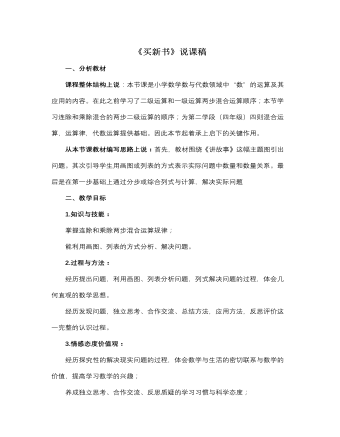
北师大版小学数学三年级下册《买新书》说课稿
2.应用意识方面,解决问题能力较差。一方面是符号意识、应用意识需要发展,从现实问题抽象出数学问题的能力和主动用数学思想分析现实问题的习惯。二是分析问题、解决问题的策略缺乏、灵活使用的能力不足(几何直观、模型思想、归纳、类比、逆向思考等方法)。五、教法、学法教法:利用谈话法,引导学生思考、探究的过程,实现教师主导下的学生的自主建构。利用讲解法,在探究学习的基础上,教师和学生共同对重点、难点进行梳理,引导学生建立清晰、系统的知识结构。利用练习法,巩固知识,发展学生的运算能力、符合意识、应用意识。学法:自主探究,有利于形成主动思考的习惯,思维能力获得提高。成功的探索使其获得理智感,有益于学习兴趣的培养。合作学习,交流比较,质疑反思的经验有利于学生创新能力的提升。合作交流同时也促进个性、社会性的发展。
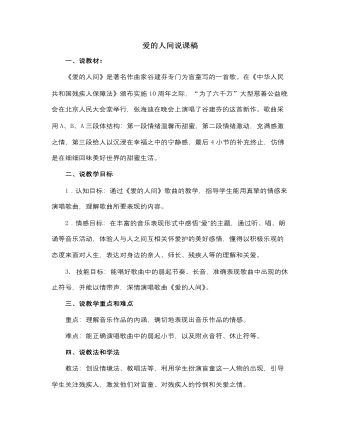
人音版小学音乐五年级下册爱的人间说课稿
2. 学唱歌词先听琴跟唱歌词,再分句解决难点:重难点:(1). 第一段中弱拍休止符的地方。(2). 附点四分音符:第一第二句的“总”, 第三句的“为”和第四句的“飘”;附点八分音符:第一第二句的“暖”,第三第四句的“总”。(3). 区分第二遍歌词和第一遍歌词在节奏上的不同之处。(4). 结束句三拍休止符。3. 完整的有表情地演唱歌曲。(三)、拓展通过欣赏邰丽华等聋哑人跳的舞蹈《千手观音》,来教育学生学习残疾人刻苦努力、奋发图强的精神;通过欣赏爱心人士的捐助图片,教育学生要帮助和帮助关心我们身边的残疾人!(四)、总结老师总结:无数个小爱汇成一个大爱,让我们在爱的人间里生活的更加美好,最后让我们再次充满感情地唱出这首爱的赞歌,在歌声中结束本课!
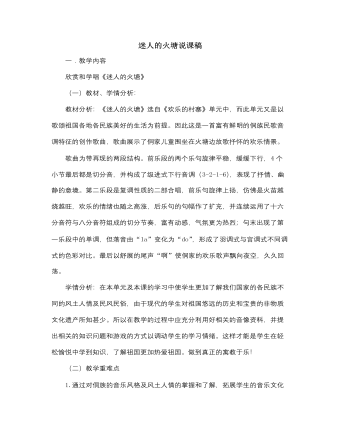
人音版小学音乐五年级下册迷人的火塘说课稿
最终使这节音乐课在这种快乐的氛围中结束,就像本课的歌曲迷人的火塘一样,那种迷人的情境永远留在我们的心中。这是课的结束部分,通过表演已学的民族歌舞与器乐演奏来巩固旧知,使主题突出,情感升华。(四)、小结:这节课我们来到了美丽的贵州,学习了一首具有鲜明的侗族民歌音调特征的创作歌曲,并了解了一些侗族的风土人情。通过今天的学习与感受,希望同学们能主动多了解些我国各民族的人文知识。为实现我们中华民族的伟大复兴而努力学习。五.教学反思本节课主要以一三四教学模式为教学方向,努力做到人人参与,小组合作,以学生为主,指导学生学习歌曲并从浅入深的让学生掌握歌曲的旋律。本节课环节过多,在时间分配上要注意,着重点要分清主次,有的环节也应该取舍得当。同时这使我明白了实践出真知的道理。我会继续努力的!
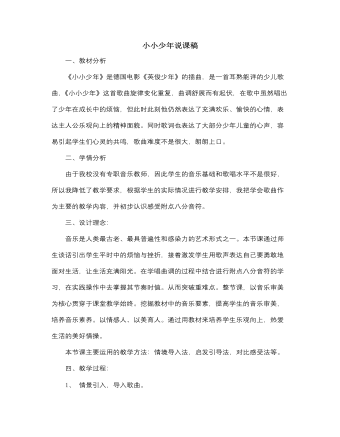
人音版小学音乐四年级下册小小少年说课稿
3、请同学朗读歌词。4、聆听歌曲《小小少年》。5、学习附点八分音符(1)看一看歌曲中用的最多的节奏是什么呢?用笔画出来。(2)听一听老师范唱与歌曲范唱的区别,哪种唱法好?(教师把附点音符改成八分音符来唱)(3)师从连音线的图解中讲解附点八分音符时值。得出结论:附点八分音符是在八分音符的基础上,延长把八音符的一半。(4)听辨练习。6、跟琴学唱曲谱,感受歌曲的弱起节奏。7、演唱歌曲分多种形式指导学生演唱歌曲。鼓励学生用明亮略带忧虑的情绪来演唱这首歌8、在《小小少年》中小主人公遇到了不小的烦恼,他被烦恼打倒从此消沉了么?他是怎样做的?我们同学的年龄跟他相仿,也许在某一天你的烦恼也会悄悄来临,希望你能象他一样用自己的智慧和爱心将困难克服掉,勇敢的迎接生活的挑战,做一个生活的强者!
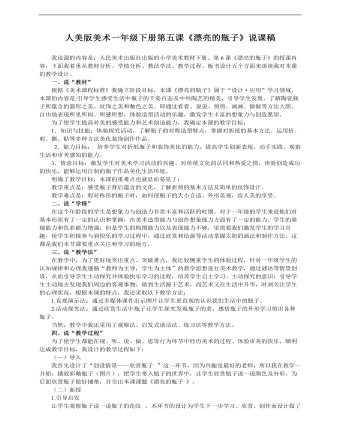
小学美术人美版一年级下册《漂亮的瓶子》说课稿
1.知识与技能:体验探究活动,了解瓶子的对称造型特点,掌握对折纸的基本方法。运用折、剪、撕、贴等多种方法美化装饰创作作品。 2.能力目标: 培养学生对折纸瓶子和装饰美化的能力,提高学生创新表现、动手实践、观察生活和审美感知的能力。3.情意目标:激发学生对美术学习活动的兴趣、对传统文化的认同和热爱之情,体验创造成功的快乐,能够运用自制的瓶子作品美化生活环境。明确了教学目标,本课的重难点也就显而易见了:教学重点是:感受瓶子背后蕴含的文化,了解折剪的基本方法及简单的纹饰设计。教学难点是:剪对称形的瓶子时,如何使瓶子的大小合适、外形美观,给人美的享受。
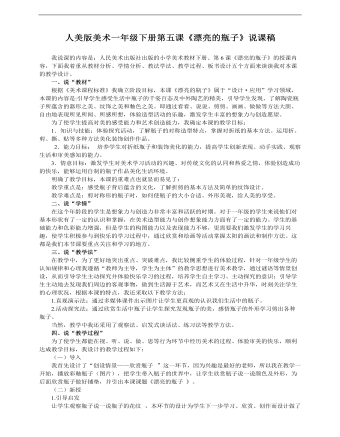
小学美术人美版一年级下册《6漂亮的瓶子》说课稿
1.知识与技能:体验探究活动,了解瓶子的对称造型特点,掌握对折纸的基本方法。运用折、剪、撕、贴等多种方法美化装饰创作作品。 2.能力目标: 培养学生对折纸瓶子和装饰美化的能力,提高学生创新表现、动手实践、观察生活和审美感知的能力。3.情意目标:激发学生对美术学习活动的兴趣、对传统文化的认同和热爱之情,体验创造成功的快乐,能够运用自制的瓶子作品美化生活环境。明确了教学目标,本课的重难点也就显而易见了:教学重点是:感受瓶子背后蕴含的文化,了解折剪的基本方法及简单的纹饰设计。教学难点是:剪对称形的瓶子时,如何使瓶子的大小合适、外形美观,给人美的享受。
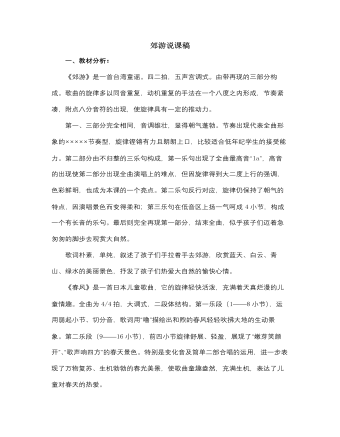
人音版小学音乐二年级下册郊游说课稿
1、听音乐熟悉旋律,整体感受歌曲。2放音乐,学生跟着老师原地按节奏踏步。有没有我们比较熟悉的乐句?3、你从刚才的歌曲中都听到了些什么内容?(教师大屏幕出示本课歌词。老师用响板把节奏打出来,学生朗读,注意读出强和弱。)4、老师发现同学们都等的不耐烦了,那就让我们随着音乐小声的唱起来吧,注意找一找有没有我们熟悉的地方?大家能不能一起唱唱?(老师弹琴,学生歌唱,注意唱的要优美。)5、歌曲处理教师启发:现在这首歌曲大家都比较熟悉,都会唱了,但是我们还是要应该把它唱得更好,你觉得怎样才能唱得更好听呢!(强弱、欢快的情绪,一、三句节奏比较紧凑,表现了小朋友们去郊游的高兴心情。第二句节奏比较舒展,表现了美丽的大自然景色。)在学生演唱歌曲的第二部分时,指导学生提前做好准备吸气,但是不要夸张的动作。慢慢吐气去唱好歌曲中的长音。注意保持气息声音不要抖。)
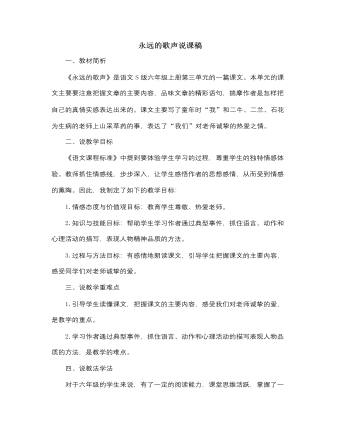
人音版小学音乐三年级下册永远的歌声说课稿
五、说教学过程为了完成本节课的教学目标,我设计了以下教学过程。1.激情导入,质疑课题首先,教师唱《小放牛》,以童年的歌声引入课文,激发学生的兴趣。同学们,走出山乡、走出童年已经很久了,真的很久很久了。童年像一幅褪了色的画,贴在记忆迷离的墙壁上,好些地方都淡得看不出线条和色彩来了,而童年的一些歌却如那山间淙淙的小溪,清亮亮地流淌着,至今仍想在我的耳边,我的耳边又响起了那永远的歌声。(板书课题:永远的歌声)接着,提出问题,为什么作者以“永远的歌声”为题?歌声里包含着什么?这两个问题也是本节课的主线,接下来的教学环节都将围绕这两个问题进行。2.初读课文,理清文章的脉络自由朗读课文,想一想课文主要讲述了一件什么事情?
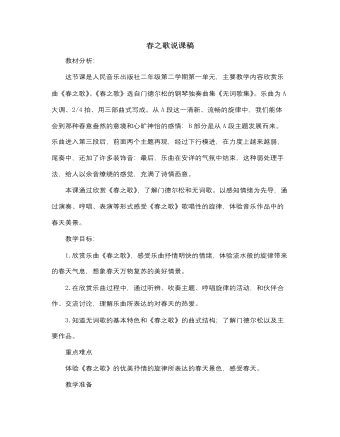
人音版小学音乐二年级下册春之歌说课稿
视频把乐曲表现的意境通过直观的图像展示,让学生进一步体会如诗如画的意境,整体感受乐曲的情绪。视频资料只是作者对这首乐曲的个人感受,所以放在最后让学生体验,而不是放在初听时用,目的在于不把学生的思维固定,放在教学阶段的最后可以让学生感受一下人们眼中的《春之歌》,开拓视野。三、拓展1.请小朋友演奏《春之歌》(《选自〈汤普森钢琴基础教程〉》)2.欣赏门德尔松的另一首无词歌《快乐的农夫》3.展示描写春天的音乐作品。四、课堂小结教学反思在充分发挥学生想象能力下,合理运用音像资料,丰富课堂、拓展视野。在本课中用丰富的音像资料,让学生了解《春之歌》以及其优美的旋律带给人们的视听享受,从而知道门德尔松的音乐成就。音乐欣赏重在对音乐作品的想象和理解,所以从情绪感知出发,通过各种音乐实践活动,运用已经掌握的课堂乐器演奏技巧,与校本教材相结合,鉴赏音乐作品,学生能很容易地记住主题旋律、得到成功的喜悦。
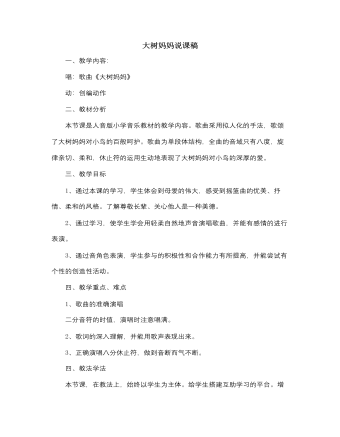
人音版小学音乐二年级下册大树妈妈说课稿
在这一环节的设置,我考虑到教育的面向全体性。让音乐教师只通过40分钟的时间就能了解,教育,检测每一个学生,这是不现实的。所以我采用了“兵带兵”的形式,建构互助式的学习模式。实践中,我发现这种方式还是需要进一步改进的。一、这样造成了课堂的拖沓。规定时间内,互助学习不能完成。二、获得的信息不够准确。再次,动作创编的“收”与“放”本节课我采用过全放的模式,结果造成了课堂的混乱。而且,学生创编的质量不高。后将“收”与“放”相结合,效果就很好。教师的主导,学生的主体都得到了很好的体现。有目的的引导学生创编,是低年级音乐教学的一个较为适宜的教学经验。最后,教学的不足教师语言需要进一步的优化。作为教师,一定要讲适合该年级段学生的语言。我在本节课,提问了“情绪、速度”。实际上,并不适合一年级小学生。换成“高兴、难受”“快、慢”会更好。